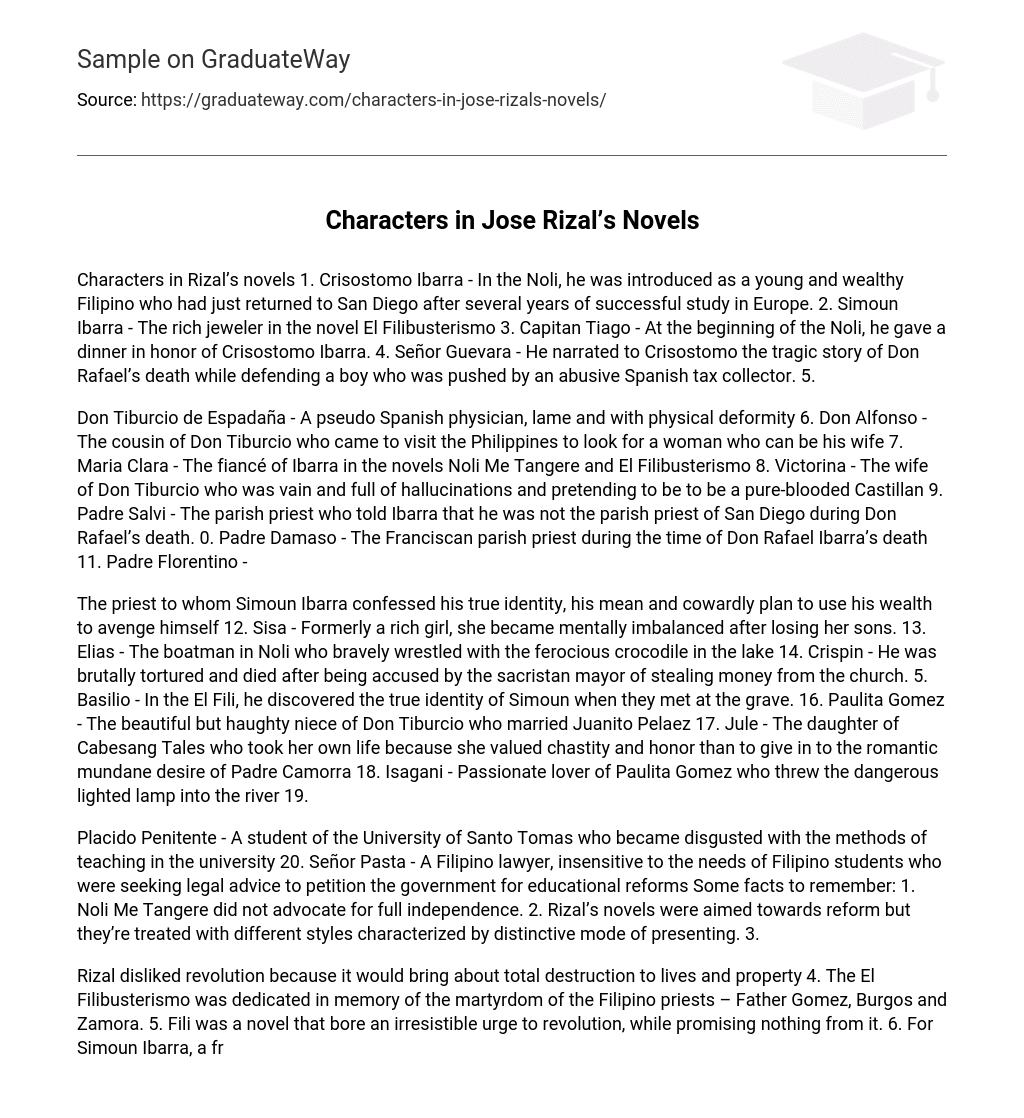Characters in Rizal’s novels 1. Crisostomo Ibarra – In the Noli, he was introduced as a young and wealthy Filipino who had just returned to San Diego after several years of successful study in Europe. 2. Simoun Ibarra – The rich jeweler in the novel El Filibusterismo 3. Capitan Tiago – At the beginning of the Noli, he gave a dinner in honor of Crisostomo Ibarra. 4. Señor Guevara – He narrated to Crisostomo the tragic story of Don Rafael’s death while defending a boy who was pushed by an abusive Spanish tax collector. 5.
Don Tiburcio de Espadaña – A pseudo Spanish physician, lame and with physical deformity 6. Don Alfonso – The cousin of Don Tiburcio who came to visit the Philippines to look for a woman who can be his wife 7. Maria Clara – The fiancé of Ibarra in the novels Noli Me Tangere and El Filibusterismo 8. Victorina – The wife of Don Tiburcio who was vain and full of hallucinations and pretending to be to be a pure-blooded Castillan 9. Padre Salvi – The parish priest who told Ibarra that he was not the parish priest of San Diego during Don Rafael’s death. 0. Padre Damaso – The Franciscan parish priest during the time of Don Rafael Ibarra’s death 11. Padre Florentino –
The priest to whom Simoun Ibarra confessed his true identity, his mean and cowardly plan to use his wealth to avenge himself 12. Sisa – Formerly a rich girl, she became mentally imbalanced after losing her sons. 13. Elias – The boatman in Noli who bravely wrestled with the ferocious crocodile in the lake 14. Crispin – He was brutally tortured and died after being accused by the sacristan mayor of stealing money from the church. 5. Basilio – In the El Fili, he discovered the true identity of Simoun when they met at the grave. 16. Paulita Gomez – The beautiful but haughty niece of Don Tiburcio who married Juanito Pelaez 17. Jule – The daughter of Cabesang Tales who took her own life because she valued chastity and honor than to give in to the romantic mundane desire of Padre Camorra 18. Isagani – Passionate lover of Paulita Gomez who threw the dangerous lighted lamp into the river 19.
Placido Penitente – A student of the University of Santo Tomas who became disgusted with the methods of teaching in the university 20. Señor Pasta – A Filipino lawyer, insensitive to the needs of Filipino students who were seeking legal advice to petition the government for educational reforms Some facts to remember: 1. Noli Me Tangere did not advocate for full independence. 2. Rizal’s novels were aimed towards reform but they’re treated with different styles characterized by distinctive mode of presenting. 3.
Rizal disliked revolution because it would bring about total destruction to lives and property 4. The El Filibusterismo was dedicated in memory of the martyrdom of the Filipino priests – Father Gomez, Burgos and Zamora. 5. Fili was a novel that bore an irresistible urge to revolution, while promising nothing from it. 6. For Simoun Ibarra, a free world can only be made after the elimination of “tyrants and slaves among nations. ” 7. For Rizal, educating for nationalism means consciously educating Filipinos to be Filipinos who will work for the country. 8.
The blueprint of Rizal for nation-building included the importance of instilling racial pride and dignity among the Filipinos. 9. For Rizal, justice is the constant and continuous will to give to every man his due. 10. Rizal believed that the power structure in the country during his time induced people to criminality and discontent. 11. Rizal advocated press freedom so that the rulers will understand the temper of their people. ESSAY QUESTIONS (Please answer these items in advance and write your answers on your white notebooks, starting from the third page.
No need to copy the questions. ) 1. Compare and contrast the Noli Me Tangere and El Filibusterismo in terms of style of presentation and treatment of the content. Discuss your answer. (10 points) 2. What is the main idea of The Indolence of the Filipinos? What do you think is the reason why Rizal wrote such essay? (10 points) 3. If you were to write a novel about the present conditions of the Philippines, what will be the title of your novel and what will it be about? What have led you to formulate such title and contents? (10 points)





